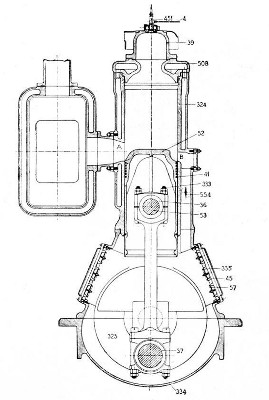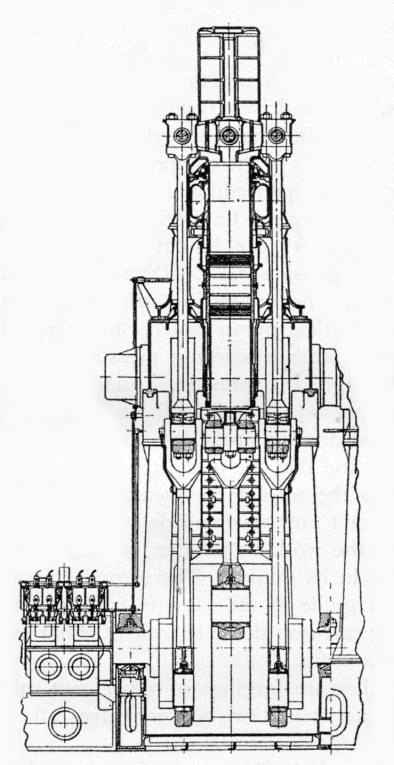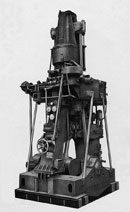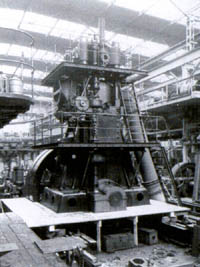| Author |
Message |
    
Bruce Lendrum
Visitor
| | Posted on Monday, January 30, 2006 - 07:13 am: | 




|
THIS MAY SOUND A BIT OFF BUT I KEEP FINDING ENGLISH TRACTOR WITH ONE-CYLINDER SEMI DEISEL POWER OF 60 HP. THIS SHOULD HAVE BEEN ONCE CONVERTED TO MARINE USE.
THE ONE THE GOT MY WAS A TWO STROKE ONE CYLINDER MADE BY THE KN FIRM IN ENGLAND IN THE 1950'S.. IT HAD A HUGE STACK AND A HEAD THAT WAS HEATED FOR STARTING..TURNED ABOUT 600 RPM .. SO A LOT OF DETAILS ON AN 44 HP UNIT... LOADS OF POWER. BURN OIL ??
AT LOW SPEEDS.. DIRECT DRIVE??
ANY THOUGHT ON THIS OR WAS THIS |
    
larry_from_maryland
Senior Member
Username: larry_from_maryland
Post Number: 286
Registered: 07-2003
| | Posted on Monday, January 30, 2006 - 06:19 pm: | 




|
I have seen those units in person and converting one for marine use would seem hard.The cylinders and head point forward with the crank sideways.So if you turn the crank inline with a proppler shaft the head would be sticking into the side of the boat,and you have to heat that head with a tourch to get it started. |
    
rayman
Member
Username: rayman
Post Number: 8
Registered: 10-2005
| | Posted on Monday, February 06, 2006 - 09:31 pm: | 




|
Bruce, the one you are thinking of is the "Field Marshal" a pretty good copy of the german LANZ, also made in australia by Kelly & Lewis in Melbourne. The biggest I have seen (single cylinder) is the swedish Zealandia, all 100hp.
Bolinder also made them that size too. |
    
Bruce Lendrum
Visitor
| | Posted on Tuesday, February 07, 2006 - 09:46 pm: | 




|
RAYMAN,
THANK-YOU FOR THE POST. THE BOLINDER POWER PLANT SURE IS MASSIVE. I FOUND A REFERENCE OF UP TO 80 HP at low 160 RPM FOR THE ONE CYLINDER MARINE POWER PLANT. |
    
Bruce Lendrum
Visitor
| | Posted on Thursday, February 09, 2006 - 06:52 am: | 




|

THIS LOOKS LIKE THE BEAST. BOLINDER HOT BULB ONE CYLINDER 80 HP SLOW TURNING. IT TOOK THREE REDUCTION TO GET THE FILE UNDER 50K SO THE QUALITY IS POOR..
THE WAY THIS WAS STARTED WAS TO TAKE A BLOW TORCH AND GET THE BULB RED HOT.. NOT THE INJECTOR SPRAYS UP TO THE TOP OF THE BULB NOT INTO THE CYLINDER SO UNLIKE A TRUE DIESEL ENGINES THE PISTON IS NOT THE HOT SPOT. |
    
Bruce Lendrum
Visitor
| | Posted on Thursday, February 09, 2006 - 07:14 am: | 




|
make that NOTE the injector spray up to the top of the bulb... sprayes on the inside where the red spot will be.
NOTE the Blow torch on the back right side and the cover for the hot bulb.. used a water drip system to keep the bulb from burning too hot at full power... in low or no power the torch keep the motor runing by keeping the spot red hot.
Bruce |
    
Bruce Lendrum
Visitor
| | Posted on Thursday, February 09, 2006 - 07:16 am: | 




|
make that NOTE the injector spray up to the top of the bulb... sprayes on the inside where the red spot will be.
NOTE the Blow torch on the back right side and the cover for the hot bulb.. used a water drip system to keep the bulb from burning too hot at full power... in low or no power the torch keep the motor runing by keeping the spot red hot.
Bruce |
    
Bruce Lendrum
Visitor
| | Posted on Thursday, February 09, 2006 - 07:34 am: | 




|

A LINE DRAWING OF THE BEAST: NOTE THE LARGE BULB.. ANY IDEA OF THE COMPRESSION?? RUN OIL OR DIESEL? OR BOTH |
    
Bruce Lendrum
Visitor
| | Posted on Thursday, February 09, 2006 - 09:42 am: | 




|



This is the power plant used to prove the effect of the single crank shaft two piston
from the Doxford site;
This engine had a bore of 500mm and equal upper and lower strokes of 750mm, designed for a normal rating of 450 BHP at 130 rpm.
Tests on this engine commenced in July 1914 and after a period of preliminary operation, the engine completed satisfactorily a 35-day full power endurance test during November and December 1914 supervised by Lloyds Register. The results more than fulfilled Doxford's expectations justified their decision to proceed with a full scale engine.
The intervention of the First World War delayed development of this project but nevertheless, during these years Doxford's research team was by no means idle. Although over the years the Doxford Engine came within the category of the slow speed engine, increasing interest in medium and high speed diesel engines, to recall that during 1915-1916 a medium speed single cylinder Doxford opposed piston oil engine, was designed and built and then acquired by the admiralty. This engine developed 400 BHP at 360 rpm in a cylinder of 370mm bore with a total stroke of 720mm employing a differential stroke arrangement the lower piston being 340mm and the upper 330mm. |
    
enginenut
Member
Username: enginenut
Post Number: 6
Registered: 01-2005
| | Posted on Thursday, June 15, 2006 - 10:42 am: | 




|
I have pictures in an english publication copyright 1918 by Chalkley of a vertical,double acting,single cyl, 2 stroke Diesel that is rated @ 2000 HP.It is pictured on the testing floor of the maker (Krupp of germany) on a generator.Dimensions were not given I think.I can FAX a pic for posting or maybe I can figure out how post from scan. |
    
Bruce Lendrum
Visitor
| | Posted on Tuesday, April 22, 2008 - 02:45 am: | 




|
1911 Sulzer builds a larger version of their 1905 engine, ushering in the age of the large slow speed two stroke engine; quite a bit larger. The one cylinder, with a meter diameter piston turns at a leisure pace of 150 rpm. It produces an astounding 1472 kW. Shortly after, they begin building a four cylinder version to produce 2760 kW.
1912 Sulzer tinkers with their 1S100, an experimental engine. It has a bore of 1 meter and holds the title, engine with the largest bore, for almost 60 years.
 |
    
wichmann
Member
Username: wichmann
Post Number: 21
Registered: 03-2006

| | Posted on Saturday, June 07, 2008 - 04:50 pm: | 




|
Tis is an norvegian fishing cutter with the orginal mainengine still i use, its av Wichmann 60-120 hp singel cyl semidiesel. The cyl bore is 420mm.
http://www.snutter.no/app/viewMovie.action?id=7020 |
    
gimmy
Visitor
| | Posted on Friday, November 06, 2009 - 10:37 pm: | 




|
gordz! |


